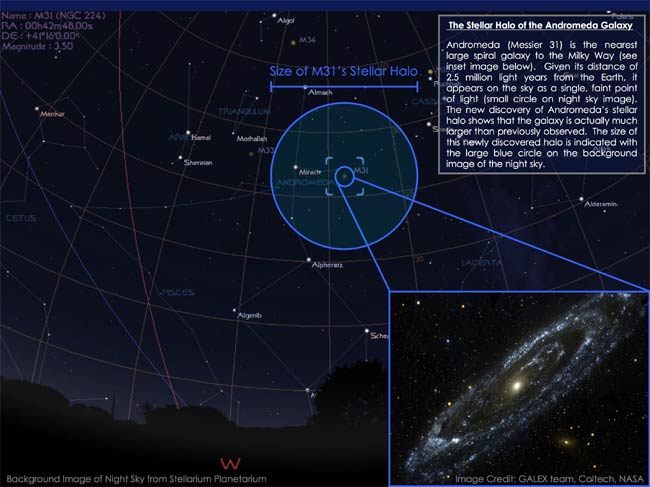
SEATTLE - The discovery of several large, metal-poor stars located far from the center of the Andromeda galaxy suggests our nearest galactic neighbor might be up to five times larger than previously thought.
The newfound stars are massive, bloated stars known as red giants. Although found far beyond the most visible portion of Andromeda-its swirling disk-the stars are still gravitationally bound to the galaxy and make up part of its extended "halo."
"We're typically used to thinking of Andromeda as this tiny speck of light, but the actual size of the halo...extends to a very large radius and it actually fills a substantial portion of the night sky," said study team member Jason Kalirai of the University of California, Santa Cruz.
The finding, presented here Sunday at the 209th meeting of the American Astronomical Society, suggests Andromeda is at least one million light-years across [image] and could help settle a discrepancy between Andromeda and the Milky Way that has long puzzled astronomers.
Andromeda
Also known as M31, Andromeda is located only about 2.5 million light-years from Earth, making it our nearest galactic neighbor.
Like our own Milky Way, Andromeda is a classic spiral galaxy, which typically consists of three main parts: a flattened disk, a bright central bulge of densely packed stars and an extended spherical halo where stars are more sparsely distributed.
Breaking space news, the latest updates on rocket launches, skywatching events and more!
Using the Mayall Telescope at Kitt Peak and the DEIMOS spectrograph on the the Keck II Telescope in Hawaii, the researchers found previously unseen red giant stars out to a distance of at least 500,000 light years from Andromeda's center.
The researchers picked out Andromeda's faint halo stars using a technique developed by Karoline Gilbert, a UCSC graduate student, which distinguishes the halo stars from the more numerous foreground stars in our Milky Way.
A dim foreground star and a bright star located much farther away-whose light can be diminished by interstellar gas-can be hard to tell apart because they appear to have similar luminosities as stars in our own galaxy. The researchers liken the effect to distinguishing between the light of a firefly 10 feet away and that of a powerful beacon in the distance.
"In this case, the fireflies are dwarf stars in our own galaxy and the beacons are the red giant stars in Andromeda," said study team member Puraga Guhathakurta, also from USCS.
Metal-poor halos
According to current galactic formation theories, the halo is the first part of a galaxy that forms. Stars in the halo are predicted to be metal poor because they formed during a time when the universe had much less heavy metal content than it does now. Heavy metals are created as stars evolve and then spewed out into interstellar space when ancient stars either explode as supernovas or shed their outer layers to become white dwarfs.
"The first stars are expected to be chemically deficient, and as these other components such as the disk of the galaxy form later, it is contaminated by the products of those first stars, so those stars are more metal rich," Kalirai said.
However, instead of being metal-poor, previous studies have found that Andromeda's halo stars were actually 10 times richer in metals than halo stars in our galaxy. This finding puzzled astronomers because both Andromeda and the Milky Way should have similar formation histories.
The new findings could solve this discrepancy because the red giant stars are anemic, as is expected from galaxy formation theories and what is known about the Milky Way.
"If you plot the metalicity as a function of radius, you see a very nice trend where the inner parts of the galaxy are metal rich, and the outer parts of the galaxy are dominated by stars that are metal-poor," Kalirai said.
"We now believe that previous groups have been mistakenly identifying the outer parts of the Andromeda bulge as its halo," Guhathakurta said.
Paul Hodge, an expert on the Andromeda galaxy from Washington University who was not involved in the study, said the new finding paints a very different picture of our galactic neighbor than was available only a few years ago.
"It's a new galaxy," Hodge said. "The outer parts of this galaxy are finally being revealed and its turning out to be much more interesting and beautiful than when could have imagined."
Editor's Note: All week, SPACE.com is providing complete coverage of the 209th meeting of the American Astronomical Society.
- The Strangest Things in Space
- Milky Way's Formation Theory Questioned
- Andromeda Galaxy: The Best of Your Amazing Images
- Life's Little Mysteries
Ker Than is a science writer and children's book author who joined Space.com as a Staff Writer from 2005 to 2007. Ker covered astronomy and human spaceflight while at Space.com, including space shuttle launches, and has authored three science books for kids about earthquakes, stars and black holes. Ker's work has also appeared in National Geographic, Nature News, New Scientist and Sky & Telescope, among others. He earned a bachelor's degree in biology from UC Irvine and a master's degree in science journalism from New York University. Ker is currently the Director of Science Communications at Stanford University.
